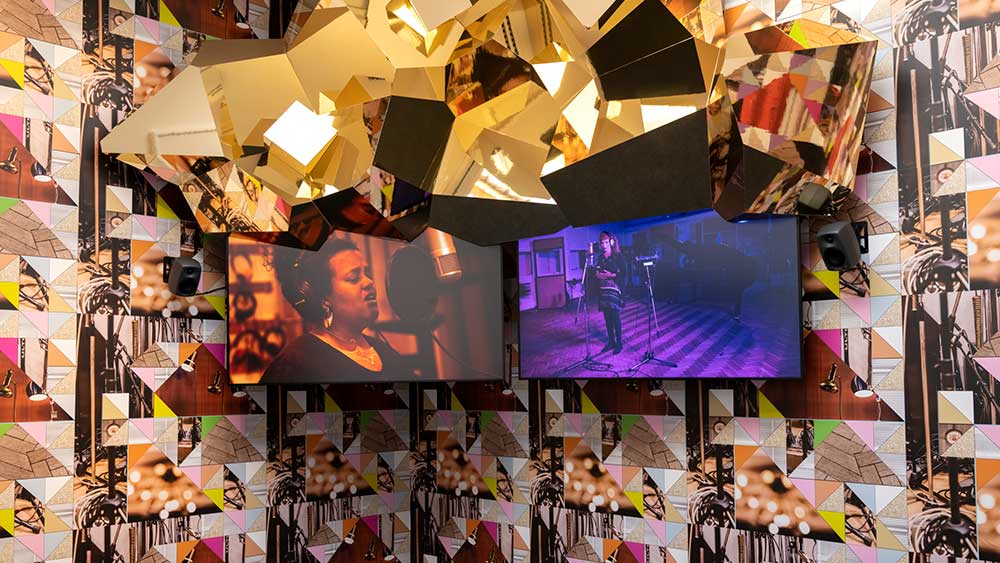
Feeling Her Way featuring performers Jacqui Dankworth and Sofia Jernberg, 2022. Photo: Cristiano Corte © British Council.
Turner Contemporary, Margate
4 February – 8 May 2023
by ANNA McNAY
“There’s a part of me that enjoys making noise,” says Sonia Boyce (b1962, London), and, certainly, on entering the first room of the artist’s five-room “immersive installation”, Feeling Her Way, at Turner Contemporary, noise is what greets me. Noise and colour, both in riotous form. But once my eyes and ears begin to acclimatise, I start to pick out the nuances, the different strains of sound and colour, the individual voices and motifs. The exhibition’s curator, Emma Ridgway, from the British Council, describes it as “an expanded collage, a layering of tessellating wallpapers of clashing colours, golden geometric structures replicating pyrite, and monochrome moving-image works, which immerse the space in the emotive sound of women singing.”1 This is the first iteration in the exhibition’s tour – further venues include Leeds Art Gallery and the Yale Center for British Art – following its winning the Golden Lion for best national participation, in the British Pavilion, at the 59th Venice Biennale last year. Throughout my visit, there is a steady footfall of all ages.
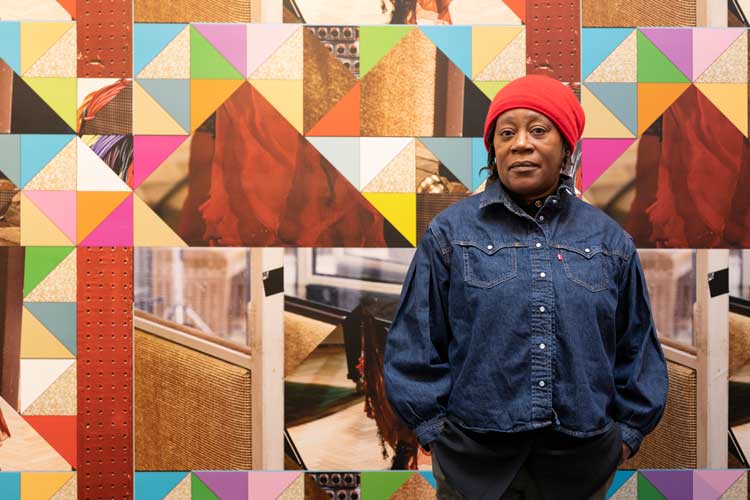
Sonia Boyce at the British Pavilion, Venice, 2022. Photo: Cristiano Corte © British Council.
Boyce, an artist and academic known for her collaborative social practice, incorporating photography, video and multimedia installation, describes her role in the project as “an editor” of material made by others. She conceived the idea of Feeling Her Way as bringing together five black female musicians “to improvise, interact and play with their voices”, asking: “What does it mean to feel free?” Poppy Ajudha (b1995, UK), Tanita Tikaram (b1969, Germany), Jacqui Dankworth (b1963, UK) and Sofia Jernberg (b1983, Ethiopia) come together with the award-winning vocal composer Errollyn Wallen (b1958, Belize), whom Boyce has tasked with leading the women to this end, in Studio Two at Abbey Road Studios, London – made famous by the 1969 Beatles album named after them.
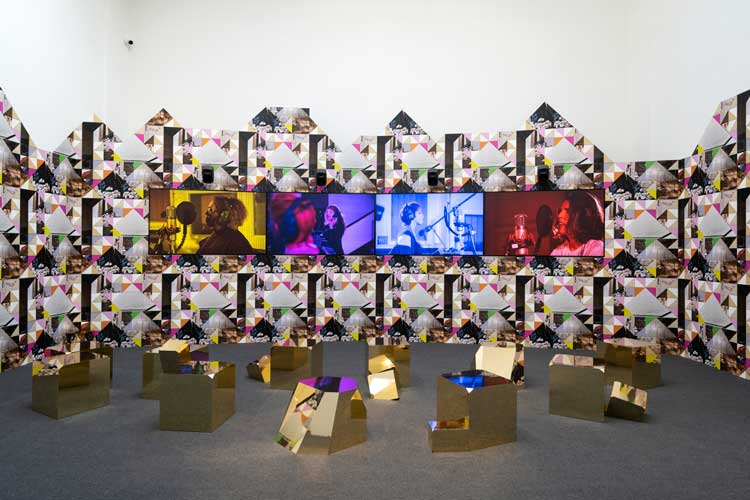
Sonia Boyce, Feeling Her Way, featuring four performers; Errollyn Wallen, Tanita Tikaram, Poppy Ajudha and Jacqui Dankworth, 2022. Photo: Cristiano Corte © British Council
The title work – playing in the first room, as the baptism by fire for visitors as much as for the artists – is the result of this session with Wallen. Across four large screens (Jernberg was unable to join the others at the last minute due to changes in international quarantine regulations because of Covid-19), each of the three singers, with her own headphones and mic, appears, at first, to be isolated – self-isolating? – in her own studio, but as the footage rolls, we see snippets of zoomed-out shots, showing them to be standing in a large circle, with Wallen (who occupies the fourth screen). And during the 12-and-a-half minutes which ensue, we hear Ajudha, Tikaram and Dankworth individually and in unison; as the great soloists they are, and left-footed as they listen and respond to, interact and “play” with one another – a simple exchange made all the more significant in the wake of time spent unable to sing in the presence of anyone because of the pandemic. Wallen leads the trio through a series of exercises: vocal slides rising as high as they can go and reaching a crescendo, expansive yawns and leonine roars, taking them – and me, as a viewer – one step beyond the self-consciousness elicited by performing “lion breath” in a yoga class. “Imagine yourself large!” shouts Wallen, who also notes: “When singing, you are at your most vulnerable, and yet powerful too.” And this growing power is palpable. Yet, at the same time, the women are almost like vessels, from which these noises and sounds emerge, as if they were speaking in tongues. Their spirits escape and fly freely around the studio, mischievously rollicking like the sprite Puck, both literally and figuratively being unmasked.
Although shot first, as a warm-up, this breathtaking performance is really the climax, or, as Boyce puts it, “the iconic moment of the whole project”. It is by far the most invigorating, empowering and powerful performance of them all. In fact, this footage is from what was intended to be the private warm-up for a group improvisation, only the latter of which was to be for public viewing, but, in the end, Boyce chose to use footage from these early stages, where each woman really is “feeling her way”, and where their trajectory is at its most apparent. The culmination comprises Wallen instructing each woman to utter a three-word phrase: “I am queen.” They sing it, shout it, emphasise different words, use different intonations … What does “queen” mean for them? Is it the same for each of them? And is this meaning static, or does it change as their manner of expression does? I am seized by an urge to join in (but for the crowded gallery!). This feels like the apogee of each singer’s realisation – and release – of her inner strength, courage and power, her inner “queen”. While swelling with shared pride, I also cannot help but laugh out loud at many of the wails, whinnies and whoops, a phenomenon backing up Ridgway’s statement that: “Language holds a privileged position in the hierarchy of communication, yet non-linguistic vocalisations express our feelings, the most common being laughter.”2
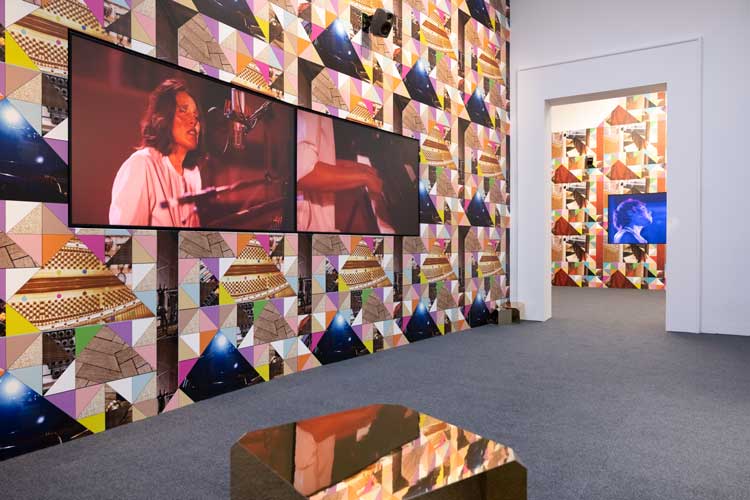
Sonia Boyce, Feeling Her Way, featuring performer Tanita Tikaram, 2022. Photo: Cristiano Corte © British Council.
For their individual performances, each singer could choose what she wanted to present. Most continued with improvisations, but Ajudha chose a short (3 minutes 36 seconds) blues-infused, acapella song, called Demons. Tikaram, although braving the unscripted, felt enough out of her comfort zone that she sought out the company of a Steinway piano, with which she shared two screens. Her near-11-minute improvisation, Instant Singer-Songwriter, is deliciously intense, with passages where she is just playing the piano, which sound almost classical. Shots of her feet working the pedals, in white pumps and red socks, provide a visual expression of “freedom”, and she vocalises this with the exquisite lines:
To feel the sun upon my face
To feel the rain between my fingers
The overall message of her lyrics, though, implies one can never be free of the past.

Sonia Boyce, Feeling Her Way, featuring the Devotional Collection, at the British Pavilion, Venice, 2022. Photo: Cristiano Corte © British Council.
The past is not, however, always cast in a negative light – in many ways, it is the source of our strength, courage and power. In 1999, Boyce began what she calls her Devotional Collection, an ever-growing archive, which she hopes might one day become a permanent museum display. It comprises items – record sleeves, cassette and CD covers, photographs, posters and other ephemera – relating to black British female musicians, who, she says, are all too frequently under-acknowledged, despite their voices belting out the vocals that form the emotional soundtracks to so many people’s lives. In the corridor-like gallery between rooms three and five, a selection of such items, collected over six months in 2021, are displayed on jagged gold ledges and against gold wallpaper – a veritable “hall of fame”. These golden rock-like structures, it should be added, also appear much larger in the other rooms, providing impromptu seating. Their form is a wry poke at colonialism and references the mineral pyrite, better known as “fool’s gold” for its being mistakenly identified as this far more valuable mineral by the supremacists. The wallpaper, made up from tessellated triangles, is like the view through a kaleidoscope, with the micro-imagery drawn from the studio footage and particular motifs Boyce associated with each artist. This pattern continues, albeit in full technicolour, pasted over the walls of the other rooms. As Ridgway contextualises: “Wallpaper has acted as scenography for decades of Boyce’s practice, the backdrop before which life’s dramas unfold.”3
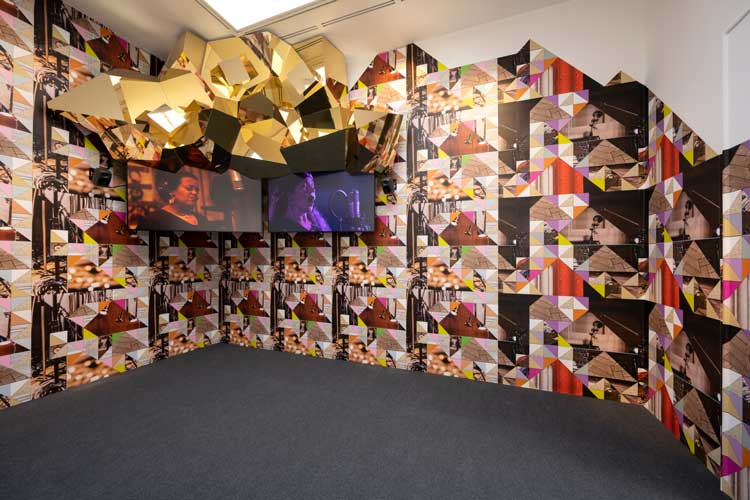
Feeling Her Way featuring performers Jacqui Dankworth and Sofia Jernberg, 2022. Photo: Cristiano Corte © British Council.
Those who read the full text accompanying the project will be rewarded by the discovery of a 17-track Spotify playlist drawn from the Devotional Collection, available to enjoy at their leisure. Sadly, All Saints are not included on this playlist (I say this because they were one of my coming-of-age bands!), but here on the wall, is the black-and-white slipcase for an “All Hits” CD distributed free with the Mail on Sunday, on which Shaznay Lewis, the only African-Caribbean British member of the 1990s girl band, appears as pale-skinned as her bandmates. For Boyce, this illustrates the unhappy state of affairs that led her to begin the Devotional Collection project: the “British confusion” about “not knowing what to do with black bodies”.4 At this point, I should perhaps confess that, back home and reading the exhibition information myself, I had to Google the five musicians, as I had not realised – and was visually unsure about the fact – that all of them are black. I don’t know, and perhaps am not the one to judge, whether this is a good or bad (or entirely irrelevant) thing. To be fair, I also did not clock the different colour filters applied to the footage of each artist – yellow for Wallen, purple for Dankworth, blue for Ajudha, red for Tikaram, and orange for Jernberg – not even when standing before the screen-printed portraits of each singer, made by Boyce, contrastingly in full colour. In fact, I was so disbelieving of the fact when I read it at home, that I had to check back with my own photographs, as not even the official press images could convince me of what I had seen with my own eyes. This is slightly disconcerting, especially since I had my “art critic” hat on at the time. All I can think of – in my defence – is that the audio sensory input was so strong that my system was entirely involved in processing that and diverted attention away from the other senses. It might also be pointed out that Boyce’s definition of “black” does not follow the strictest sense of “belong[ing] to a race of people with dark skins, especially a race from Africa”,5 but the looser sense, whereby it references all and any whose skin tone is “other” than white. As she explains in a text co-authored with the art historian Dorothy Price:
Colonial discourses about race and difference between Africans and Europeans became reduced to a binary system, an epidermal and corporeal schema, in which African people in the African diaspora were continually positioned as inferior. “Black” was relegated; it languished as the “other” to normative whiteness and continues to signify a deficit that speaks of difference. “Black” bodies became matter out of place, interlopers to the recognisable norm, hived off as a form of symbolic boundary-maintenance. And “black” remained a pejorative term for centuries until it was discursively “reclaimed” in the wake of the American civil rights and Afro-European liberation struggles of the post-colonial era. Yet in more recent configurations such as BAME or BME, the terms “black and Asian”, or “black and brown” bodies, suggest a doubling of displacement: a hierarchy within the abstraction of non-normative groups of people.6,7
The final room, separated from the others by this “hall of fame”, is really two rooms in one, with performances by Dankworth and Jernberg. At the far end, Dankworth’s solo piece, Reach Out (7 minutes 53 seconds), is sung in tribute to her 95-year-old mother, jazz and pop singer Cleo Laine. At the other end, two screens play Jernberg’s “instrumental” improvisation, filmed in a studio in Stockholm, in which she manipulates her voice to produce all manner of strange sounds, and a second piece by Dankworth. Together, these comprise For Sonia, which runs for the same length of time as Reach Out. The three recordings therefore interact with one another, similarly to the women’s voices in the group improvisation, Feeling Her Way. The version you hear is very different, depending on where you are standing (or, in my case, sitting) in this final room. I preferred being positioned in front of the two-screen “duet”, where I could hear Jernberg’s “music” accompanied by certain phrases wafting over – or, indeed, “reaching out” – from Reach Out, as if hearing a redacted version of its lyrics. Even more so than in the warm-up, these voices interweave to create a concerto, simultaneously existing as individuals and as a harmonised – and harmonising – whole. I sat riveted for at least six loops, becoming more and more immersed, and discovering further nuances each time around.
The concept of “feeling her way” might be applied to many walks of life, but especially those where someone, to some extent, feels like a fish out of water, be that a woman in a man’s world; a black person in a white world; a disabled body in an able-bodied world; a neurodivergent mind in a neurotypical world … For me, it resonates on numerous levels, but first and foremost it evokes the idea of being “unmasked” and expected to respond and perform without being able to follow a rehearsed script. I am not just talking in terms of improvised singing in a studio, but of “performing” everyday life and interactions, many of which come as second nature to the majority of the population, and all the fear and faltering uncertainty that this engenders. I can imagine the hashtag trending on social media: #feelingherway. And this project really is a journey of “feeling her way”, too: for the singers, of finding their voices, their courage, their strength and their power, and using them all intuitively and instinctively, experimenting and experimental, responding to the senses rather than to reason; but for visitors equally so, as we undergo an experience akin to being blindfolded and having our other senses become heightened in response.
Ridgway writes that Feeling Her Way “represents identities as multi-vocal, underlining [Boyce’s] pluralist understanding of humanity”.8 Yet, in seeming contradiction, she summarises Boyce’s use of the term black “as being an imperfect yet inclusive term, referring to an identity drawn together through British notions of empire and the subjugation of the colonial ‘other’”.9 I would suggest, then, that the journey undertaken here is one that is both individual and collective, adding tothe collective history of (black, British, female) music, a living embodiment of Boyce’s Devotional Collection. Moreover, though, the journey is one undertaken by performer and audience, individually, but also collectively as women – or woman.
“The best-case scenario for me,” says Boyce, “would be that people are touched by the work – I mean emotionally touched.” Through one sensory channel or another, I would say this is inevitable. The final words voiced by Dankworth, as you prepare to leave the final room, are: “Never let it go.” This, I think, is the perfect conclusion: now that you have found that strength, courage, power, and freedom, never let it go.
References
1. Sonia Boyce. Feeling Her Way by Emma Ridgway and Courtney J Martin, exhibition catalogue, published by Yale University Press, 2022, page 45.
2. Ibid, page 90.
3. Ibid, page 77.
4. Ibid, page 105.
5. This is the definition given by the Collins English Dictionary online.
6. Cited in Ridgway and Martin, 2022, page 111.
7. It might be noted that Boyce’s definition of British (for the Devotional Collection) also casts a relatively wide net, with no requirement for the musician to have been born in the UK. This, however, is also fairly common today, especially in sectors, including the art world, where nations are keen to lay claim to those who find success from within their borders.
8. Ridgway and Martin, 2022, page 48.
9. Ibid, page 56.
• Sonia Boyce: Feeling Her Way will be at Leeds Art Gallery from 26 May to 5 November 2023.